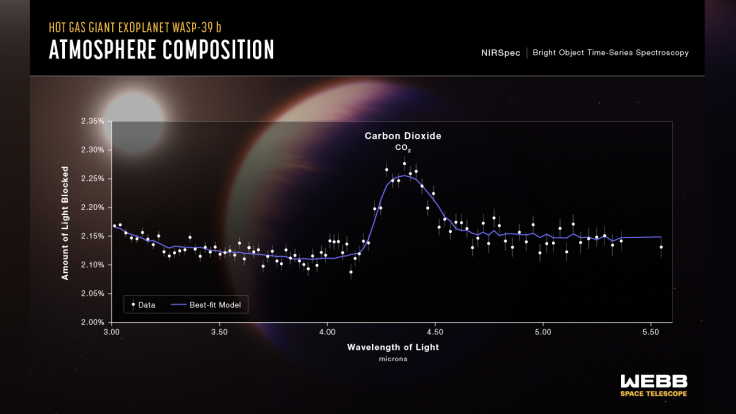NASA's newest high-end space observatory is proving to be a worthwhile investment.
The space agency recently announced that the James Webb Space Telescope (JWST or simply Webb) had captured the first clear evidence of carbon dioxide in the atmosphere of a planet outside our solar system.
Scientists call Webb's discovery "a special moment" as it crossed "an important threshold in exoplanet sciences," per Webb's official website.
Webb's Carbon Dioxide Discovery Details
NASA announced in its statement that Webb had captured the first clear evidence of the existence of carbon dioxide in a planet's atmosphere.
The planet, which is named exoplanet WASP-39b, is a hot gas giant orbiting a Sun-like star 700 light-years away from Earth.
NASA's research team was able to discover carbon dioxide in WASP-39 b's atmosphere by using Webb's Near-Infrared Spectrograph (NIRSpec) for its observations of WASP-39b.

According to Interesting Engineering, Webb's NIRSpec was able to do such a feat due to its ability to work through filtered starlight, which is based on the concept that different gases absorb various combinations of colors.
The difference in brightness can then be analyzed by researchers when cross-referenced with wavelength spectrums, allowing experts to determine the composition of a planet's atmosphere.
Experts found a small hill between 4.1 and 4.6 microns in the spectrum of the planet's atmosphere. This small hill presents the first clear, detailed evidence of carbon dioxide ever detected on a planet outside the solar system.
Furthermore, the measurements of WASP-39b's atmosphere were gathered on July 10, two days before NASA released Webb's first images, per Space.com.
NASA notes that no observatory has ever measured differences in brightness of various individual colors across the 3 to 5.5-micron range in an exoplanet transmission spectrum before.
Zafar Rustamkulov, a graduate student at John Hopkins University and member of the JWST Transiting Exoplanet Community Early Release Science team, is allegedly the first to discover Webb's achievement.
"As soon as the data appeared on my screen, the whopping carbon dioxide feature grabbed me," Rustamkulov said. "It was a special moment, crossing an importnat threshold in explanet sciences."
Laura Kreidberg, director of the Max Planck Institute for Astronomy in Germany, said that the discovery of carbon dioxide in an exoplanet's atmosphere is a critical moment in astronomy. She added that the exoplanet community has been searching for the signature of carbon dioxide for decades.
With Webb's capabilities, Kreidberg believes it is now possible to routinely detect the gas in question for "hot Jupiters" and smaller, cooler planets like Earth.
WASP-39B Details
Aside from being around 700 light-years away from Earth, WASP-39b has almost the same mass as Saturn and roughly one-quarter of Jupiter's, though its diameter is 1.3 times greater than our Gas Giant.
Unlike Jupiter and the other gas giants in our solar system, WASP-39b orbits its parent star very closely, with it being only about one-eighth the distance between the Sun and mercury.
This short distance allows the exoplanet to complete a single revolution in just four Earth days.









